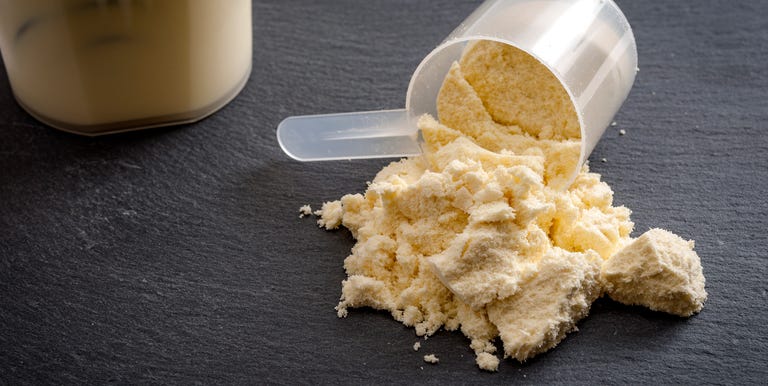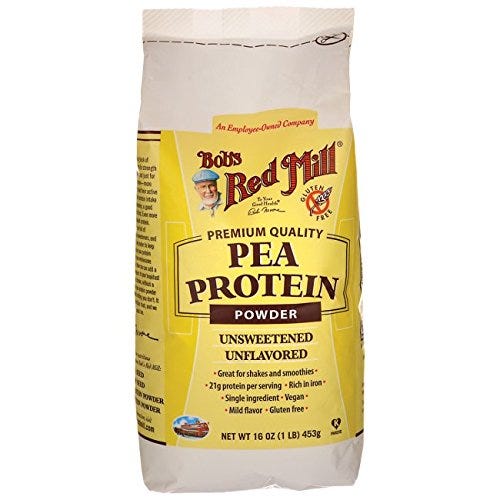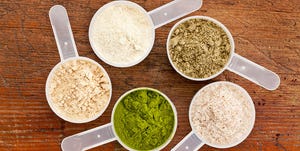
When I was a kid, I remember hating when my dad insisted I ate every last pea on my plate at dinnertime.
It’s safe to say that 6-year-old me would be kind of horrified that peas—specifically, pea protein—are in everything these days, from veggie burgers to vegan-friendly protein powders.
Anyone else craving warm breakfast bowls lately? This one has it ALL, oatmeal, bananas, berries, almond butter and check out those blue energy balls! ?@vegamelon #porridge #oatmealbowl #energyballs #peaprotein #proteinballs
A post shared by Natural.Simple.Clean (@flosuperfoods) on
? Surely we’re not the only ones frothing over these bad boys ? Recipe below ⬇️ ・・・ ✖ INGREDIENTS ▫️1 banana ▫️1 cup of oats ▫️1 tsp baking powder ▫️1/4 tsp baking soda ▫️3tbsp @Tropeaka Lean Protein Chocolate ▫️1tsp @Tropeaka Cacao Powder ▫️1/2 cup plant milk of choice ▫️2 eggs & 2 egg whites (or flax eggs for vegan) ✖METHOD ▫️Pop all that in the blender, blend till smooth and make yo’self some pancakes ▫️Topped with banana, macadamia nut butter, raspberries, pecans and choc sauce ・・・ ? recipe and piccy by @jordyns_channel ・・・ ?️Our organic, raw cacao powder comes from the seeds of the native South American evergreen, which are found in the large oval shaped pods of the tree. . Cacao is a nutrient dense and less refined version of cocoa (what is used in chocolate ?), and hasn’t been heated and treated at the same temperatures, allowing the cacao to keep its nutrient dense qualities. . Cacao is packed full of antioxidants and contains magnesium, calcium, sulfur, zinc, iron, copper, potassium, manganese and vitamins: B1, B2, B3, B5, B9, C and E ?. . It’s a high ORAC antioxidant superfood that is rich in minerals to make you feel healthy all over ??. Our cacao will be sure to leave you feeling happy and healthy! . Cacao is sustainably and organically grown by the farmers ?????? of the Yanesha communities in the Pasco region of Peru and has been used for hundreds of years as a nourishing and energising food for the South American people. . Best of all it has an amazing chocolate taste ✅ and can be used in desserts, drinks, chocolate creations and smoothies! ・・・ ? TAP PICCY TO SHOP NOW ? WORDLWIDE SHIPPING AVAILABLE ・・・ Tropeaka.com #tropeaka . #pancakes #plantbased #humpday #peaprotein
A post shared by Tropeaka (@tropeaka) on
But yeah no, people are not just eating pea-flavored protein shakes. (Six-year-old me—and adult me—shudders at the thought.) Pea protein is so, so much more than that.
What is pea protein?
Pea protein is extracted from green and yellow split peas, according to the University of Michigan. It’s used to make protein powder, and often serves as a base in packaged foods like veggie burgers (oh hai, Beyond Burger!) and vegan mayo, and even replaces dairy in some ice creams and “milks.”
“As more and more consumers are looking to plant-based items, pea protein powder interest has soared among my clients,” says Alexandra Caspero, R.D.

You might wonder, why peas? Well, the legume is naturally rich in protein, at 11 grams per quarter cup. And peas are a vegan source of protein (more on that in a sec) making it a great option for plant-based people who want to add more of the nutrient to their diet.
A single serving of pea protein powder, for example, nets you around 90 to 120 calories and 17 to 24 grams of protein, depending on the brand, making it pretty comparable to other types of protein powders. (Note: Flavors may potentially add more sugar.)
Pea protein powder is also an excellent source of iron, at around five milligrams (mg) per serving—nearly a third of your daily needs, making it ideal for vegans, notes Caspero.
Here’s what you get in a quarter-cup serving of Caspero’s favorite pea protein powder, Bob’s Red Mill Pea Protein Powder (which is unsweetened and unflavored):
Pea protein benefits
As mentioned above, pea protein is totally plant-based, making it safe for vegans to eat. Remember, most other types of non-meat protein alternatives (whether they’re protein powders or packaged foods) include dairy, whey, soy, and/or eggs, says Jessica Cording, R.D.
Cording also recommends pea protein-based products to people with allergies (since lots of people are lactose-intolerant, or have soy, wheat, or egg allergies). Pea protein tends to be pretty easy to digest, she adds, although you may have a reaction if you’re allergic to other legumes like peanuts.

Like all other protein powders, a shot of pea protein after workouts may reduce soreness and speed recovery while boosting muscle mass gains. What’s more, pea protein has loads of the amino acid arginine, which may help lower blood pressure, according to the Mayo Clinic (although more research is needed). As a plant-based food, pea protein is also kinder on the environment than animal-based proteins, since peas need less water and energy to grow than, say, a cow.
Pea protein vs whey protein: Which one is better?
Pea protein is similar in calorie and protein levels to whey protein, Cording says. Pea protein, however, is not a complete protein like whey is, meaning it doesn’t contain all of the essential muscle-building amino acids your body needs.
But as long as you eat a variety of other healthy proteins and whole grains like rice throughout the day, you’ll make up the essential amino acid requirements to make pea protein complete, explains Caspero.
Is pea protein better than other plant-based proteins?
If you’re sensitive to gluten, lactose, soy, or dairy, says Caspero, pea protein is usually much easier on your tummy than most other types of protein powders. It’s also thought to be less genetically modified than some soy protein powders, Cording adds.
As far as plant-based proteins go, “pea protein has a very mild taste and palatable texture that blends easily into other foods and with other flavors,” says Cording.
You can use pea protein powder just like you would any other kind of protein powder: as a base for a protein shake, stirred into baked goods, blended into smoothie bowls, you name it.
“Overall, I’m a big fan and would encourage it to someone looking for an alternative to whey or soy protein,” says Cording.

Check the label carefully, since some protein powders are way more processed and filled with added sweeteners, flavors, colors, and preservatives. Caspero likes the above-mentioned Bob’s Red Mill Pea Protein Powder since it only has one ingredient: yellow peas.
Not into powders? Cording suggests just eating fresh or frozen peas, which contain the same protein-boosting power plus nearly triple the fiber in a quarter-cup serving, plus other phytochemicals and nutrients that may get stripped during processing.
The bottom line: Pea protein is actually a food trend worth trying, especially if you’re vegan or have food allergies. Just be sure to eat a well-balanced diet to ensure that you’re getting a complete range of amino acids.
Source: Read Full Article